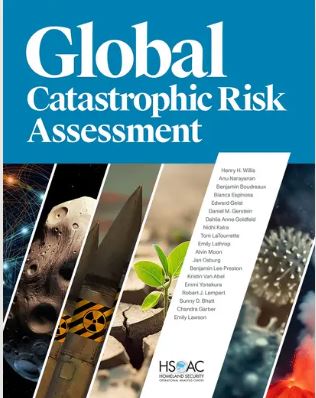
October 30, 2024

Global catastrophic and existential risks hold the potential to threaten human civilization. Addressing these risks is crucial for ensuring humans’ long-term survival and flourishing. Motivated by the gravity of these risks, Congress passed the Global Catastrophic Risk Management Act in 2022, which requires that the Secretary of Homeland Security and the administrator of the Federal Emergency Management Agency coordinate an assessment of global catastrophic risk related to a set of threats and hazards. The U.S. Department of Homeland Security Science and Technology Directorate and the Federal Emergency Management Agency requested the Homeland Security Operational Analysis Center’s support in meeting this requirement. The authors of this report document findings from the resulting analysis.
This report summarizes what is known about the risks associated with six threats and hazards: artificial intelligence; asteroid and comet impacts; sudden and severe changes to Earth’s climate; nuclear war; severe pandemics, whether resulting from naturally occurring events or from synthetic biology; and supervolcanoes.
The risk summaries cover the following aspects: where feasible, estimates of the likelihood and potential consequences of each risk; factors causing the risk and associated uncertainties; and whether the risk is likely to change in the next decade.
Because the broader goal of the Global Catastrophic Risk Management Act is to reduce risk to human civilization, the authors also identified known and potential mitigation strategies for the six threats and hazards and drew insights from the assessment relevant to managing the risks they pose to society.
Key Findings
- The risk management practices needed to address the sorts of risks covered in this report improve understanding of the risks, prevent the occurrence of the hazard or threat, or reduce the consequences of the event if it occurs.
Overall, global catastrophic risk has been increasing in recent years and appears likely to increase in the coming decade
- For supervolcanoes and asteroid and comet strikes, risk should remain constant or decrease in the next decade.
- For the remaining threats and hazards, the risk appears to be increasing in the next decade because of current or expected human activities.
- For artificial intelligence, the uncertainties are sufficiently large that it is difficult to determine the extent or magnitude of changes in risk with any confidence.
A few key factors govern the changes in risks from these six threats and hazards
- The key factors governing risk change for these threats and hazards are the rate and nature of technological change; the maturity of global governance and coordination; failure to advance human development, thereby threatening societal stability; and interactions among the threats and hazards themselves.
- These hazards and threats can vary widely in terms of the geographic extent over which one can expect consequences to occur and the quality of understanding about their scope, likelihood, and consequences.
Recommendations
- Incorporate comprehensive risk assessments into management of global catastrophic and existential risks.
- Develop a coordinated and expanded federally funded research agenda to reduce the uncertainty surrounding global catastrophic and existential risks and to improve the capabilities for managing such risks.
- Develop plans and strategies when global catastrophic and existential risk assessments are supported with adequate evidence.
- Expand international dialogue and collaboration on addressing global catastrophic and existential risks.
- Adapt planning and strategy development to address irresolvable uncertainties about global catastrophic and existential risks.




